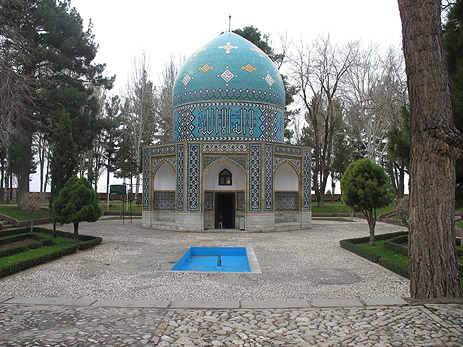Image Resource Bank
Image Gallery |  7 of 15
7 of 15 
Mausoleum of Farid al-Din ‘Attar
The mausoleum of `Attar, pictured here, was built through the patronage of another famous poet, ‘Ali Shir Nava’i (d. 1501 CE). Many mystic poets, such as Ibn al-Farid (d. 1235), Rumi (d. 1273), Sa`adi (d. 1283/1291 (?)), Hafez (d. 1389-90), and others would have mausoleums built over their tombs to honor their legacy not as poets but as popular saints.
As was common of fifteenth-century Iranian architecture, the building features pointed arches and a pointed dome, an abundant amount of glazed tile-work (particularly in blue and turquoise), as well as geometric and calligraphic designs. The tall and large white writing on the drum of the dome reads la ilah ila Allah, or “There is no god but God,” a phrase known as the shahada. This tomb also reflects the basic design of the Dome of the Rock in Jerusalem, as the Dome of the Rock, with a central dome rising above an eight-sided building, became a common model for Muslim buildings centering around a specific point (whether it be the Rock the Dome of the Rock was built over, or in this case ‘Attar’s tomb), as opposed to a mosque, which is built to face one distant direction: Mecca.
Name: Mausoleum of Farid al-Din ‘Attar
Material: Stone, brick, and glazed tiles
Size: Unknown
Date: Built sometime before 1501 CE
Place of Origin: Nishapur, Iran
Location: Nishapur, Iran
Source and Registration#:
Wikimedia![]() , (accessed February 5, 2010).
, (accessed February 5, 2010).
Creative Commons Copyright![]()
Attribution: Work of Nik Pendaar
License: Creative Commons Attribution ShareAlike 2.5![]()

 Michael Sells
Michael Sells
John Henry Barrows Professor of Islamic History and Literature, Divinity School, The University of Chicago




